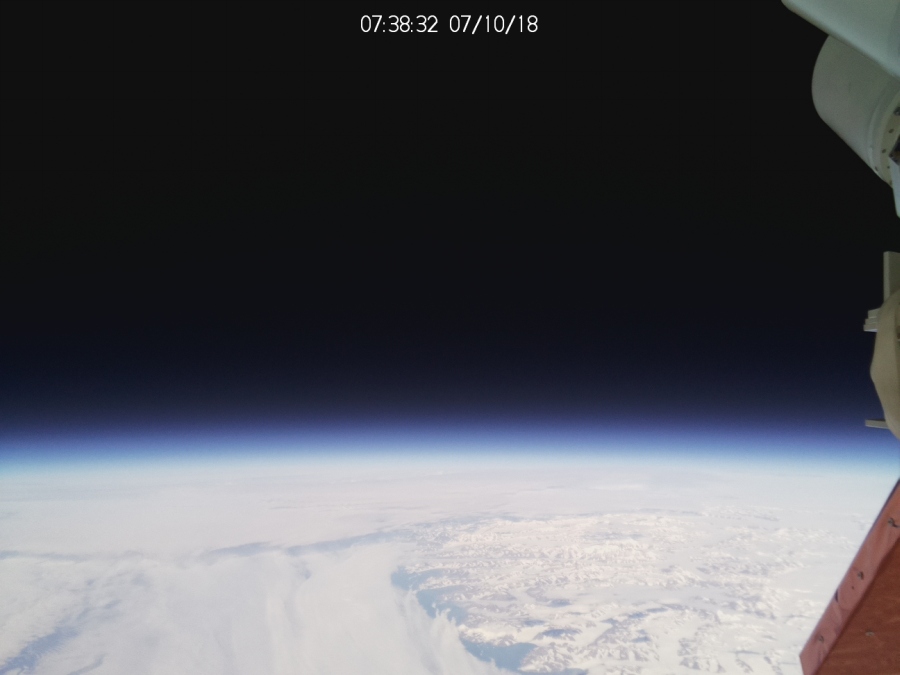Balloon Campaign - PMC-Turbo - Scandinavia 2018
Home | News | Quicklooks | Telemetry | Contact | Live Stream
Safely on the ground (14 July 2018)
The gondola landed safely in northern Canada at 04:47 UTC today. At 0447 squibs cut the steel cables which connect the payload and parachute to the balloon, sending the payload on a free fall to ground. A maximum downward velocity of about 60 m/s was recorded by the onbard sensors before the parachute slowed the payload down to a speed of roughly 4 m/s on impact. Then, after touchdown, the parachute was separated from the payload in order to avoid the gondola being dragged on ground should a wind gust inflate the parachute again.
According to the picture (see below) taken by one of the onboard cameras shortly after landing, the gondola appears to be upright and on dry land. No damage is visible. This marks the end of a very exciting and successful balloon mission and we would like to thank everyone involved.
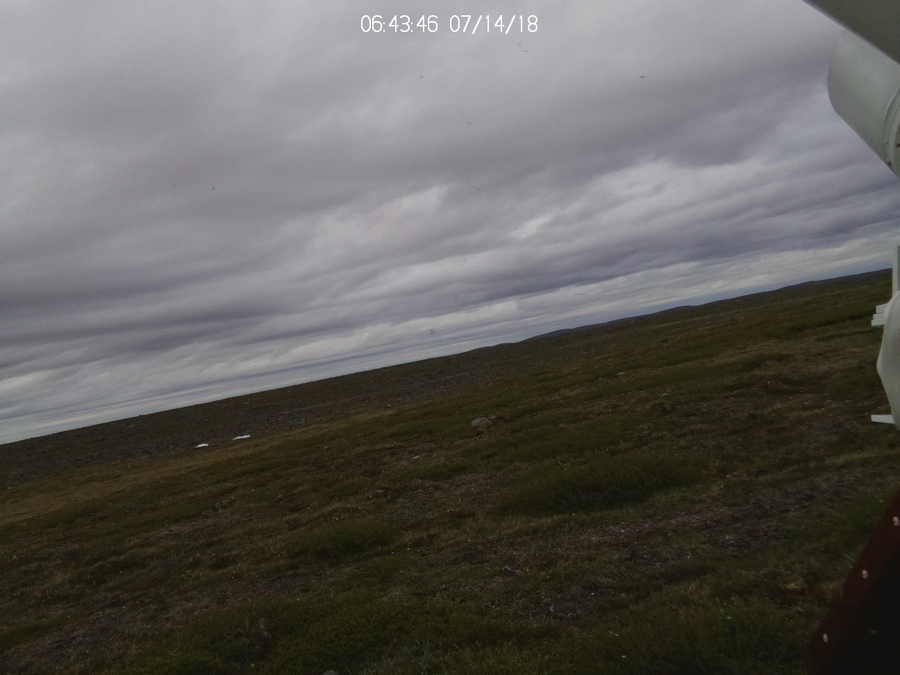 The payload on the ground. The payload on the ground. |
The gondola has landed (14 July 2018)
0740LT - Flight was terminated at 0447Z and the gondola touched down at 0536Z. Coordinates 66°46'48.4"N 109°22'16.0"W.
0305LT - The gondola left the primary landing zone and is now west of 106°W. About two hours until termination.
0230LT - We are at 5 days and 17 hours and just set a new record for an Arctic flight.
Day 5 (13 July 2018)
2345LT - We just finished a rotation test during which we rotated the gondola from -120 degrees to +120 degrees in azimuth (0 degrees points the solar arrays towards the sun and our scientific instruments anti-sun). The purpose of this test was to map flares and stray light observed by the scientific cameras. The picture below shows temperatures measured at various parts on the telescope. It is interesting to see how quickly temperatures can change when parts are exposed to direct sunlight. For example, there are two sensors which measure the temperature of the upper collar on the telescope (Collar left and Collar right). The collar is made of black anodized aluminum. Within about 10 minutes of being exposed to direct sunlight the temperature rose from -20°C to about 75°C!
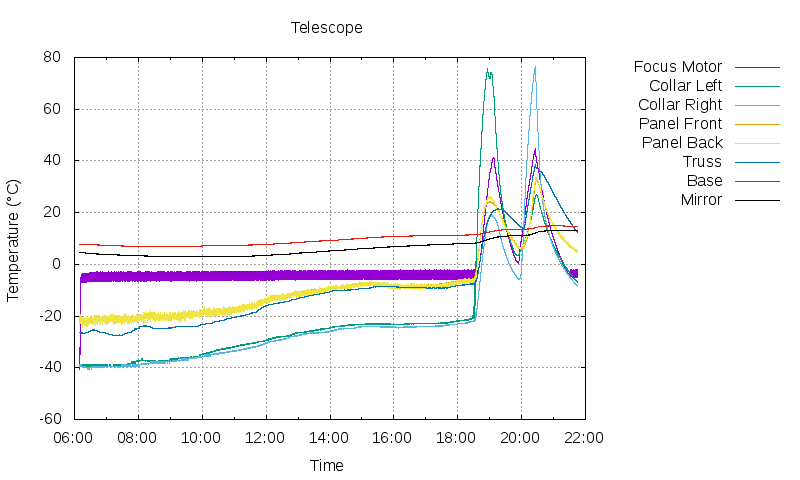 |
1913LT - The decision was made to bring the gondola down in the western landing zone.
1602LT - The balloon crossed the first landing zone and will reach the second landing zone in about 8 hours. No decision has been yet made whether to terminate in the second landing zone or go further and terminate near Great Bear Lake. Real time tracking information is available here.
1447LT - The gondola is now above the Canadian mainland and drifting with west with about 35 knots. This morning we could observe the shadow zone approaching the position of the gondola. While the land below falls into darkness, the balloon remains in constant daylight due to its high altitude of about 39 km. As it is getting later in the season and the balloon drifts further south, the period when we see the land in darkness is getting longer each day. Eventually the gondola would also experience darkness, however that is not to happen until late July.
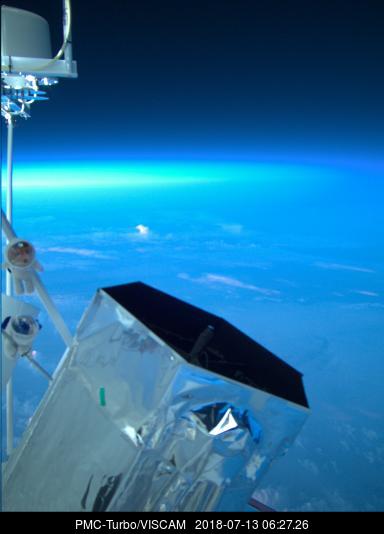 Most of the land below the gondola lies in darkness and while the horizon is brightly lit. Most of the land below the gondola lies in darkness and while the horizon is brightly lit. |
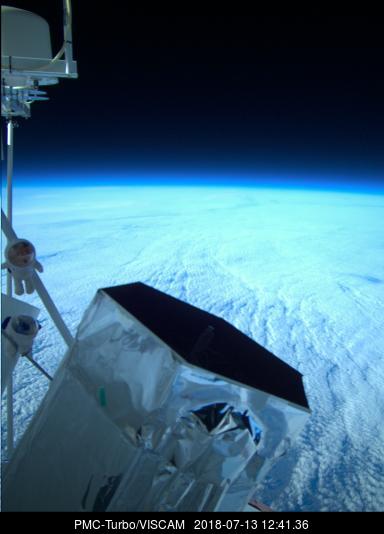 A recent image. A recent image. |
0854LT - The lidar is back in an operational state and collecting science data. The cause of the loss of telemetry was a faulty disk in the camera leader computer. This is the computer through which our lidar telemetry is routed and reformatted before being sent to ground. For a reason we do not understand right now, the issue caused the control software running on the lidar main computer to hang, and we had to reboot the lidar computer and restart the lidar data acquisition. Now everything is back to normal except for an actuator on the telescope which experienced very low temperatures (<-40°C).
0703LT - We are currently experiencing some issues with our telemetry and are not able to downlink any science data. Investigation is in progress.
The picture below shows the balloon, rotator (white cylinder below the balloon) and part of the suspension system of the gondola. It was taken by one of our upward looking cameras installed in the lidar pressure vessel.
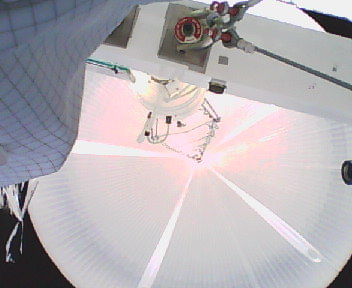 |
Day 4 (12 July 2018)
0932LT - The balloon crossed the Davis Street and arrived at Baffin Island. There is just one more larger patch of open water ahead of us, the Northwest Passage.
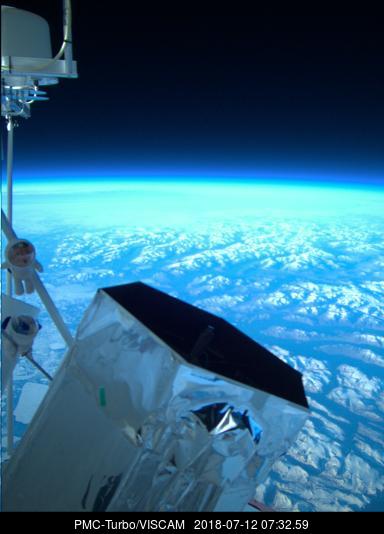 Baffin Island Baffin Island |
0701LT - We are now at 3 days and 21 hours flight time and all instruments are working well. The most recent PMC was detected in lidar data about an hour ago and now we appear to be in a region void of clouds. The balloon has left Greenland an is now on its way towards northern Canada where the flight will be terminated in approximately two days. At present we are discussing options where exactly we want to terminate, as we are trying to avoid lakes, rivers and populated areas. On the one hand we want to have as long of a flight as possible and collect as much science data as possible, on the other hand we want to make sure that the gondola, and in particular the hard disk with the data, can be recovered. There are more lakes towards the west of the projected flight path which results in an increased chance of landing in water. The lidar and cameras are housed in pressure vessels and are thus protected if splashed with water. However, we do not know how deeply the vessels can be submerged in water before they are crushed.
 Track of the balloon and forecasted trajectory. Track of the balloon and forecasted trajectory. |
Day 3 (11 July 2018)
0728LT - Spectacular clouds. For the past few hours we observed spectacular ice clouds with both the lidar and camera instruments. The picture below shows clouds as seen by the lidar. The brighter the color, the stronger the lidar backscatter and thus the thicker the cloud. There is also a lot of fine structure within the clouds, for example stacked layers which are only a few meters thick and separated by few hundred meters. The length of the image segment is roughly one hour and the vertical scale is approximately 4.5 km with a vertical resolution of 30 meters. A real time display of the clouds can be found here.
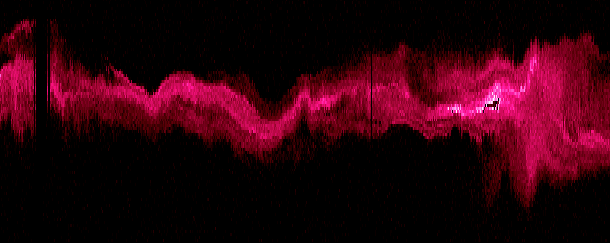 Noctilucent clouds as seen by the lidar instrument. Noctilucent clouds as seen by the lidar instrument. |
Operations here at the science user area in the hangar at Esrange have become smoother as we gained more experience in operating the instruments onboard the balloon gondola. Also, there were less issues with the satellite data links and overall telemetry and commanding have become more stable and reliable during the past 24 hours, requiring us less often to change the data links and adapt the downlink bit rates. We expect to loose the TDRSS downlink between 1500Z-2000Z today (the satellite will be down for software upgrades) which however will likely not hamper our ability to downlink lidar data. The lidar bit rate is approximately 18 kbit/s on average and can be accommodated on the remaining links.
Christopher left Esrange yesterday for Yellowknife in Canada where recovery of the gondola will be staged. According to the latest trajectory forecasts termination will occur sometime on Saturday.
Day 2 (10 July 2018)
1010LT - Made it to Greenland! As of 20 minutes ago Greenland is in the view of rear looking onboard camera. The lidar and scientific cameras are running well and we acquired exciting data during a several hours long PMC event last night. Concerning operations, one of the more exciting events last night was a total power outages at the control center in Palestine, Texas. As a consequence, we lost all but one satellite data link to the payload for some hours (Iridium OpenPort is the only link which is fully independent). Now all links are restored and both science and engineering data are again coming down normally.
Day 1 (9 July 2018)
0935LT - We are nearing the end of our first day at float. Most recent activities included handover of balloon operations to the control center in Palestine, Texas, just before we lost our line of sight connection. At about 6LT this morning we switched to over the horizon commanding and telemetry (satellite links). The lidar is running smoothly with no major issues. We lost telemetry a couple of times which resulted in the laser kill timer running out, but restart was accomplished quickly each time. First signatures of PMC/NLC were detected in real time lidar data a few minutes after we switched on the lidar for the first time. Since then PMC were present during roughly 50% of the time. That is less than we have hoped for, but at least the instruments are working and we acquired already interesting data.
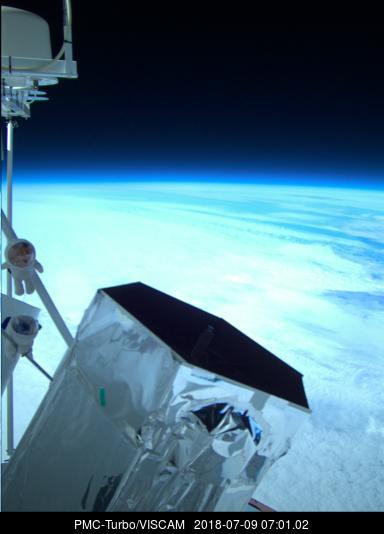 A picture taken by the onboard camera showing the lidar telescope in the foreground. A picture taken by the onboard camera showing the lidar telescope in the foreground. |
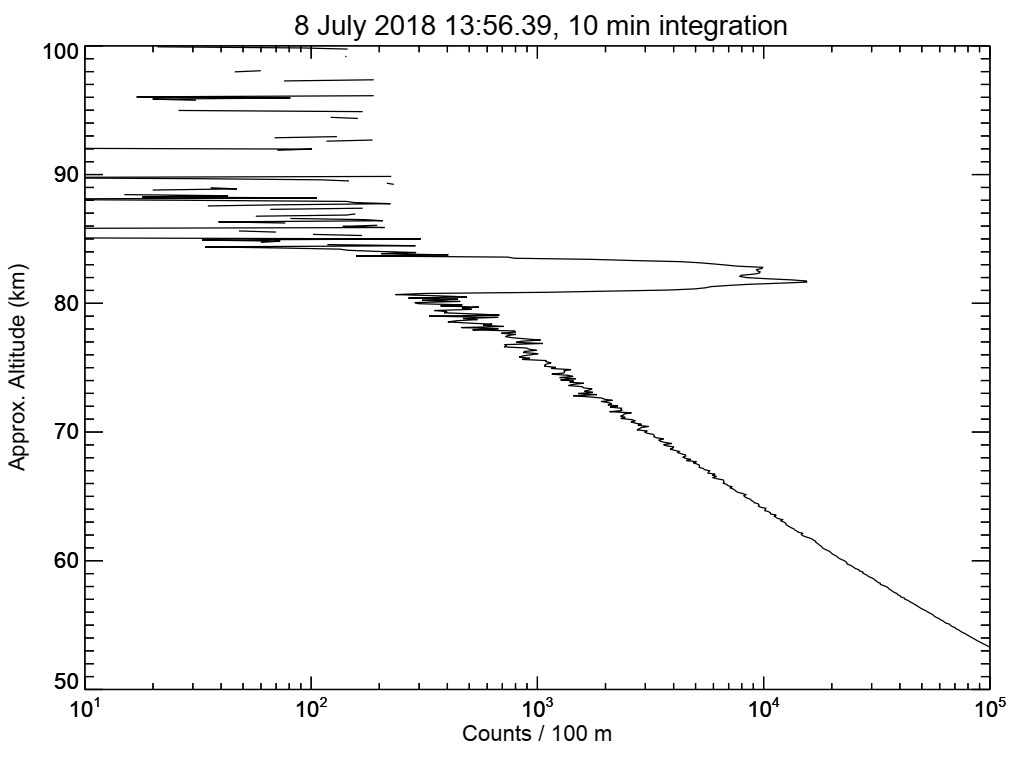 Backscatter profile acquired by the lidar. The spike at around 80 km altitude is caused by PMC/NLC. Backscatter profile acquired by the lidar. The spike at around 80 km altitude is caused by PMC/NLC. |
Launch (8 July 2018)
1843LT - We launched at 0927LT / 0727Z today. The first hours were very exciting as we ran through some telemetry issues. However, the solar arrays produced more current than we had anticipated and we stayed power positive during most of the ascent. The lidar was switched on at 90.000 ft and the beam was successfully acquired shortly after.
 PMC-Turbo before launch. PMC-Turbo before launch. |
 Shortly after launch. Shortly after launch. |
0819LT - Balloon is being laid out. We will launch in about 80 minutes.
0640LT - Communications tests completed, lidar tests completed. Payload was moved to flight position. Winds are looking good.
0340LT - We are moving the gondola outside for tests of the satellite data links.
0155LT - Pickup delayed due to risk of precipitation.
0049LT - First part of lidar tests completed. Communication checks started.
